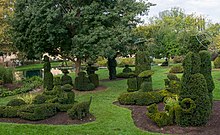
Columbus is the capital and most populous city of the U.S. state of Ohio. With a 2020 census population of 905,748, it is the 14th-most populous city in the U.S., the second-most populous city in the Midwest after Chicago, and the third-most populous U.S. state capital after Phoenix, Arizona and Austin, Texas. Columbus is the county seat of Franklin County; it also extends into Delaware and Fairfield counties. It is the core city of the Columbus metropolitan area, which encompasses ten counties in central Ohio. It had a population of 2,138,926 in 2020, making it the largest metropolitan area entirely in Ohio and 32nd-largest metro area in the U.S.
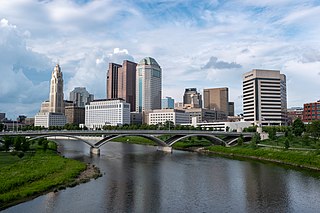
The Columbus, Ohio metropolitan area is a metropolitan area in Central Ohio surrounding the state capital of Columbus. As defined by the U.S. Census Bureau, it includes the counties of Delaware, Fairfield, Franklin, Hocking, Licking, Madison, Morrow, Perry, Pickaway, and Union. At the 2020 census, the MSA had a population of 2,138,926, making it 32nd-most populous in the United States and the second largest in Ohio, behind the Cincinnati metropolitan area. The metro area, also known as Central Ohio or Greater Columbus, is one of the largest and fastest-growing metropolitan areas in the Midwestern United States.

Downtown Columbus is the central business district of Columbus, Ohio. Downtown is centered on the intersection of Broad and High Streets, and encompasses all of the area inside the Inner Belt. Downtown is home to most of the tallest buildings in Columbus.
Columbus, the state capital and Ohio's largest city, has numerous neighborhoods within its city limits. Neighborhood names and boundaries are not officially defined. They may vary or change from time to time due to demographic and economic variables.
The Ohio Arts Council (OAC) is an agency serving the U.S. state of Ohio. Its offices are in the Rhodes State Office Tower in Columbus, Ohio.

Harrison West is a historic urban neighborhood located northwest of downtown Columbus, Ohio. It sits on several blocks along the Olentangy River and includes the western part of the Near Northside Historic District, which was placed on the National Register of Historic Places in 1975. The character of the neighborhood is similar to Victorian Village, which sits just to the east and is more well-known.
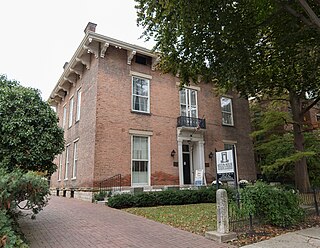
The Kelton House Museum and Garden is a Greek Revival and Italianate mansion in the Discovery District of Downtown Columbus, Ohio. The museum was established by the Junior League of Columbus to promote an understanding of daily life, customs, and decorative arts in 19th-century Columbus and to educate visitors about the Underground Railroad.
The culture of Columbus, Ohio, is particularly known for museums, performing arts, sporting events, seasonal fairs and festivals, and architecture of various styles from Greek Revival to modern architecture.

John F. Wolfe Columbus Commons is a 6-acre (2.4 ha) park and green space in downtown Columbus, Ohio, located on the site of the former Columbus City Center mall. The park features gardens, a performance stage, carousel, interactive playground equipment, and two foodservice buildings. The project was developed by Columbus Downtown Development Corporation (CDDC) and Capitol South Community Urban Redevelopment Corporation. The park opened on May 26, 2011.
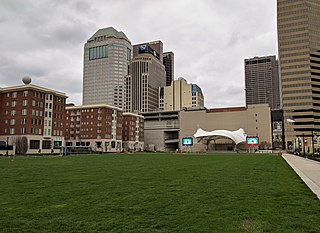
Highpoint on Columbus Commons is a $50 million mixed-use development project in Columbus, Ohio consisting of both multi-family and retail space. Highpoint includes 301 apartments and townhomes, built with approximately 23,000 square feet of street-level retail fronting on High Street, the main north–south thoroughfare through Columbus, Ohio. Highpoint on Columbus Commons was the first new residential development to occur at Columbus Commons, a seven-acre site in downtown Columbus that stands at the former site of the Columbus City Center mall.

Franklin Park is a neighborhood located on the Near East Side of Columbus, Ohio. Both the historic neighborhood and landmark, the Franklin Park Conservatory and Botanical Gardens, are named after the 88-acre park.

The Main Library of the Columbus Metropolitan Library (CML) system is located in Downtown Columbus, Ohio, United States. The public library is the largest in the library system and holds approximately 300,000 volumes. It includes numerous rooms, including separate spaces for children, teens, an adult reading room, newspaper room, auditorium, gallery, gift shop, and a cafe. The third floor includes a computer lab and houses the Franklin County Genealogical & Historical Society.
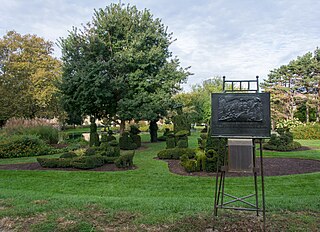
Topiary Park is a 9.2-acre (3.7 ha) public park and garden in Columbus, Ohio's Discovery District. The park's topiary garden, officially the Topiary Garden at Old Deaf School Park, is designed to depict figures from Georges Seurat's 1884 painting, A Sunday Afternoon on the Island of La Grande Jatte. It is the only park based entirely on a painting.

The Columbus Civic Center is a civic center, a collection of government buildings, museums, and open park space in Downtown Columbus, Ohio. The site is located along the Scioto Mile recreation area and historically was directly on the banks of the Scioto River.

The East Town Street Historic District is a historic district in Downtown Columbus, Ohio. The site was listed on the National Register of Historic Places in 1976 and the Columbus Register of Historic Properties in 1982; the district boundaries differ between the two entries.
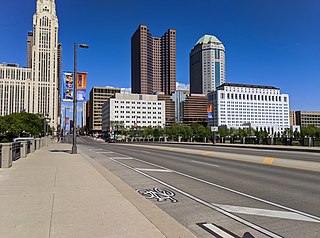
Broad Street is a major thoroughfare in Central Ohio, predominantly in Franklin County and Columbus. It stretches east from West Jefferson at Little Darby Creek to Pataskala. The street is considered one of Columbus's two main roads, along with High Street.
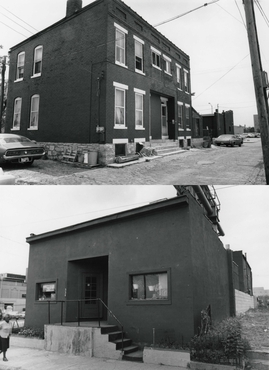
The Elijah Pierce Properties were historic buildings in Downtown Columbus, Ohio. They were listed on the National Register of Historic Places in 1983.
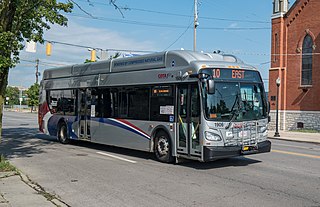
The 10 E Broad / W Broad is a Central Ohio Transit Authority (COTA) bus service in Columbus, Ohio. The line operates on Broad Street, the city's main east-west thoroughfare.
MKSK is an American landscape architecture and urban design firm. The company is headquartered in Columbus, Ohio, founded in 1990. The firm is known for its work reshaping Central Ohio, particularly downtown Columbus. MKSK is an employee-owned practice with a network of twelve metropolitan studios in Ohio, Illinois, Indiana, Kentucky, Michigan, South Carolina, Georgia, Florida, and the District of Columbia.

The Ohio Institution for the Deaf and Dumb was a deaf school campus in Downtown Columbus, Ohio. The school, today known as the Ohio School for the Deaf, sat on the present-day Topiary Park grounds in the modern-day Discovery District. The main school building was gutted by a fire on October 2, 1981, though an existing building still stands as Cristo Rey Columbus High School. That remaining building is listed on the National Register of Historic Places and Columbus Register of Historic Properties.





